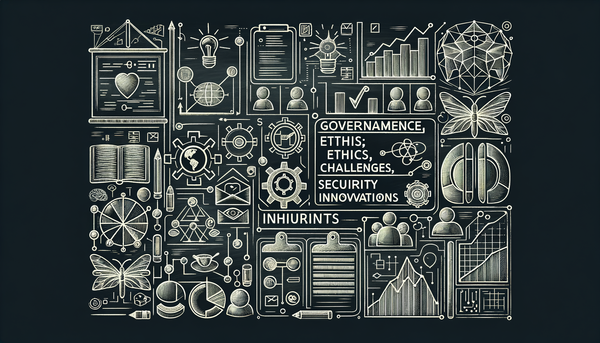AI News Podcast Update: Innovations and Challenges in AI
Advanced AI developments are now rattling the geopolitical stage and transforming everyday digital experiences—with experts warning on national security risks while innovators push boundaries in AI-driven browsing and personalized services.
Balancing Innovation with National Security
Recent debates over advanced AI chips have brought national security back into the spotlight. A coalition of 20 national security experts has called on policy makers to reconsider the export of Nvidia’s H20 chips to China. They argue that this new generation of optimized AI inference hardware is designed to surpass even the capabilities of previously restricted models and could significantly boost both civilian technology and military systems in rival nations.
Critics of the chip sales emphasize that by bypassing export control thresholds, these advanced components could be misused—enhancing the adversary's ability to deploy cutting-edge AI models. One can easily see how such a move might deepen existing chip bottlenecks in the United States, further threatening the long-held technological edge and national defense capabilities. As one expert poignantly stated,
By far, the greatest danger of Artificial Intelligence is that people conclude too early that they understand it. - Eliezer Yudkowsky
This sentiment underscores the complexities inherent in balancing technological innovation with strategic caution.
For readers interested in a broader perspective on these evolving security debates, AI.Biz’s latest update offers additional insight into how policy and technology are intricately intertwined, particularly when national supremacy hangs in the balance.
Revolutionizing User Experiences: Voice-Activated and AI Browsing
Another frontier of AI innovation is at our fingertips—with voice-controlled systems progressively redefining our digital experiences. Microsoft’s rollout of Copilot Mode for Edge is a prime example of this evolution. This transformation has turned the Edge browser into a futuristic, voice-activated digital assistant that streamlines web navigation by anticipating user needs. Gone are the clunky interfaces of outdated digital assistants; the modern Copilot is sleek, intuitive, and designed to work gently in the background, waiting to be summoned when needed.
This voice-driven mode is more than just a fancy feature. It exemplifies how browsers can go beyond the traditional click-based interactions to offer a more personalized, multimodal experience. The new mode analyzes context across multiple open tabs, enabling it to help users quickly locate a specific moment in a video or sift through multiple pages for a particular detail—even offering features reminiscent of a digital concierge. With impressive safety measures in place to protect privacy, users have the freedom to opt in or out as their needs shift.
Microsoft’s journey into voice-assisted web navigation demonstrates the industry’s push for ever-more integrated AI applications. Reports from trusted outlets, including detailed explorations on TechRadar and PCWorld, illustrate how Microsoft is bridging the gap between functionality and futuristic design. If you’re curious to test drive these innovations firsthand, exploring the dedicated Copilot experience might be a captivating experiment that reflects how far browsers have come.
AI Integration in Everyday Applications
The transformative influence of AI is not confined to advanced security or futuristic browsing alone. Everyday applications are increasingly powered by AI, revolutionizing how consumers interact with technology. For instance, Google Chrome’s introduction of AI-powered store summaries offers U.S. shoppers a quick, data-backed snapshot of a store's reputation. By employing information from platforms like Trustpilot and ScamAdviser, these summaries highlight essential details regarding product quality and customer service—thereby empowering users to make informed decisions with a simple click.
Such features exemplify the blending of convenience with robust technological infrastructure. They also underscore how AI can drive efficiency, seamlessly integrating customer feedback with practical usability. This adaptive approach in consumer technology reflects broader trends in retail, where AI agents are not just streamlining services but also enhancing the overall journey—from product discovery to the final purchase decision.
In a similar vein, innovative applications like ElevateAI for contact centers (detailed in AI.Biz’s dedicated reports) underscore the diverse potential of AI. Whether it is boosting customer service efficiency or dissecting market trends for actionable insights, the push towards AI-driven personalization is reshaping industries in ways we are only beginning to understand.
Political Dynamics and the Future of Tech Governance
The intersection of technology and political power in recent years underscores how deeply intertwined policy and innovation have become. In one compelling discussion on the Uncanny Valley podcast, experts dissected the shifting influence of Silicon Valley in Washington, D.C. The narrative details how the Trump administration’s aggressive AI plan—with over 90 proposals aiming to deregulate and adapt to a rapidly changing tech landscape—signals a new era of political dynamics in tech governance.
This shift raises important questions about the long-standing partnership between tech giants and policy makers. The evolving stance—ranging from deregulation targets to strategic realignments with political power—reveals a broader trend where technology companies must navigate not only innovation but also their political and economic influence.
As debates persist about the right balance between fostering innovation and imposing necessary oversight, it becomes clear that policymakers are having to rethink their approaches. The emergence of a more assertive role for political entities in dictating the pace of technological adoption prompts one to wonder if the once-unassailable Silicon Valley influence is finally being met with stronger counterweights in D.C.
This evolving landscape is a reminder that while technological breakthroughs capture headlines, the underlying power dynamics play a crucial role in determining how innovation is adopted on the global stage.
Emerging Frontiers: Healthcare and Scientific Discoveries
The influence of AI extends well beyond consumer and political spheres, permeating the realms of healthcare and scientific research. Novel applications of AI, such as those seen in gene set analysis powered by expert-curated databases, are beginning to offer unprecedented accuracy in bioinformatics and personalized medicine. Although details on some of these advances, like the AI agent performance in gene analysis or AI-powered meal logging for continuous glucose monitoring users, have yet to be widely publicized, the promise of these technologies is unmistakable.
Innovations in the field of medicine are significant due to their potential to transform patient care and improve health outcomes. In tandem with advances in biotech and drug discovery—such as initiatives looking to accelerate pan-coronavirus drug discovery—the ability of AI to analyze vast datasets has ignited new research paradigms. These technologies are not only enhancing diagnostic precision but also improving treatment strategies and personalized approaches to healthcare.
Furthermore, while the transformation of gene-based analysis is still in its infancy, the very idea of leveraging AI to mine expert-curated datasets holds enormous future potential. Researchers and healthcare professionals alike are excited by the possibility of real-time, data-driven insights that could lead to tailored therapies and more proactive patient care.
The Dynamic Future of AI
In the spirit of innovation and continuous evolution, it is fascinating to observe how AI is simultaneously challenging existing paradigms and creating new frontiers in multiple sectors. From redefining national security policies to revolutionizing browsers and consumer applications, the AI landscape is a mosaic of rapid transformation and thoughtful caution. The interplay between technological breakthroughs and their societal implications is a recurring theme that demands both enthusiasm and vigilant oversight.
Looking back at these developments, it is evident that the future of AI lies in a harmonious blend of innovation and responsibility. As Steve Jobs once noted,
In the future, computing will be so natural that it will be invisible to us. It’s going to integrate into our lives seamlessly.
This vision is becoming a reality on multiple fronts, as demonstrable examples—from voice-enabled digital assistants to AI-driven store summaries—are slowly but steadily carving a new way forward for both consumers and policymakers.
For enthusiasts and skeptics alike, the road ahead is filled with both challenges and extraordinary possibilities. Whether it is the ethical debates around privacy in AI browsing or the strategic reckoning of advanced chip exports, one thing remains clear: the narrative of AI is continuously evolving. I invite you all to stay engaged, explore these technological leaps, and be a part of this vibrant conversation on innovation and responsibility.
Further Readings
- AI News Podcast Update: Innovations and Challenges in Technology
- Exploring Recent Advancements in Artificial Intelligence
- Latest Developments in AI: A Comprehensive Overview
- AI News Podcast: Updates on Policy, Research, and Innovations
Reflections on the Journey Ahead
The accelerating pace of AI innovation is a testament to the creativity and ambition of both industry leaders and researchers. Its ability to transform user experiences—from powering voice-activated browsers to analyzing genetic data—continues to captivate us. As the dialogue between technology and policy deepens, one cannot help but marvel at a future where intelligence, be it human or artificial, is seamlessly woven into the fabric of everyday life.




